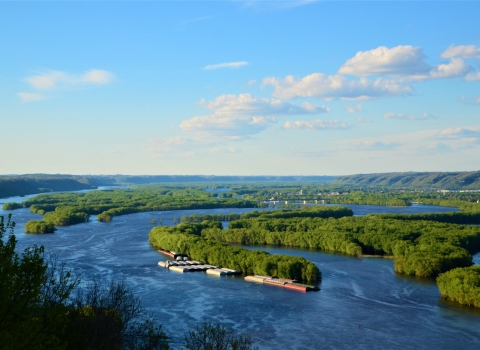WASHINGTON — The U.S. Fish and Wildlife Service today announced nearly $10 million in fiscal year 2025 funds from President Biden’s Bipartisan Infrastructure Law to support 53 strategic projects in Western states focused on habitat restoration and on-the-ground science, as well as for additional strategic capacity to bolster habitat restoration and community resilience in the face of a changing climate. Projects will support management of invasive grasses, reduce wildfire risks, remove conifers, and restore sagebrush habitat.
In fiscal year 2025, more than $1 million of the nearly $10 million in Bipartisan Infrastructure Law funding will be directly invested in conservation work with Tribal partners.
Through President Biden’s Investing in America agenda, the Department of the Interior is implementing more than $2 billion in investments to restore our nation’s lands and waters. To guide these historic investments, and in support of the President’s America the Beautifulinitiative, the Department unveiled the Restoration and Resilience Framework, to support coordination across agency programs and drive transformational outcomes, including a commitment to restore core sagebrush area through the Sagebrush Keystone Initiative. By working collaboratively with ranchers, state and local governments, Tribal nations, the outdoor recreation community, and other stakeholders, the Department is working to build ecological resilience in core sagebrush habitats and make landscape-scale restoration investments across sagebrush country.
“It’s more important than ever to improve landscape resilience by managing invasive annual grasses and safeguarding water resources throughout sagebrush country to address impacts from climate change climate change
Climate change includes both global warming driven by human-induced emissions of greenhouse gases and the resulting large-scale shifts in weather patterns. Though there have been previous periods of climatic change, since the mid-20th century humans have had an unprecedented impact on Earth's climate system and caused change on a global scale.
Learn more about climate change and increased wildfires,” said Service Director Martha Williams. “These shovel-ready projects are addressing the highest priority threats to sagebrush ecosystem health and improving watershed integrity both in this arid landscape and downstream to support the people and wildlife who call this area home.”
Spanning over 175 million acres in the Western United States, sagebrush country contains biological, cultural and economic resources of national significance. America’s sagebrush ecosystem is the largest contiguous ecosystem in the continental United States, comprising one-third of the land mass of the lower 48 states. Sagebrush landscapes have long been a home to Tribal and rural communities, a driver of agricultural economies, and a host for a diversity of wildlife, including the greater sage-grouse, migrating herds of big game, and more than 350 species – many of which live nowhere else in the world.
Some examples of projects funded in fiscal year 2025 include:
Prioritizing Mesic Resources in High Value Watersheds in Idaho (Idaho), $172,000. The goal of this project is to restore mesic stream habitats in the sagebrush landscape using a watershed-scale approach. Natural resource partners in Idaho are developing standardized plans and practices to streamline restoration of degraded stream systems. Members of the “Idaho Stream Team” include the Fish and Wildlife Service, Idaho Department of Fish and Game and many private landowners who focus on holistic rangeland management.
Ute Mountain Ute Tribe - Gunnison Sage Grouse Habitat Improvement and Management Project, Pinecrest Ranch (Colo.), $206,346. This project will benefit birds which depend on the sagebrush environment, including the Gunnison sage-grouse, and occur on Tribal land owned and managed by the Ute Mountain Ute Tribe. This project is expected to restore and enhance 116 wet meadow acres and support grazing management of both upland and wet meadow habitats across 6,876 acres.
Northwestern Nevada Large-Scale Rangeland Restoration (Nev.), $308,500. The goal of this project is to reduce the spread of invasive annual grasses through herbicide application and native seeding, which will improve overall rangeland conditions in and around core sagebrush habitats in northwestern Nevada. This project is in collaboration with the Summit Lake Paiute Tribe and Nevada Department of Wildlife.
See a full list of fiscal year 2025 projects on the Sagebrush Conservation website.
The Service is committed to working with local communities, state and federal agencies, Tribes, conservation groups and private landowners to ensure they have the tools they need to conserve these important areas. Sagebrush funding is allocated to existing and new projects based on priorities established by the Service’s Sagebrush Ecosystem Team and partners, including the Western Association of Fish and Wildlife Agencies. The SET, WAFWA and others are using the Sagebrush Conservation Design – a landscape-scale tool to prioritize conservation investments in sagebrush – to collaboratively defend and grow intact, functioning sagebrush geographies and mitigate the primary threats to sagebrush ecological health, namely invasive grasses and wildfire, drought and encroaching conifers. By anchoring conservation in these areas, the Service and its partners can focus on working to restore degraded lands and habitat through the “Defend the Core, Grow the Core” approach endorsed by the Western Governors Association and a growing number of partners working across the West.
To learn more about the importance of the Bipartisan Infrastructure Law, tune into the Nature’s Infrastructure podcast each month as we host conversations with project partners, Tribal nations, and other stakeholders about the positive conservation and restoration impacts these projects are having on ecosystem restoration, climate resiliency, habitats and communities around the nation.
-FWS-
The U.S. Fish and Wildlife Service works with others to conserve, protect and enhance fish, wildlife, plants and their habitats for the continuing benefit of the American people. For more information, visit www.fws.gov and connect with us on social media: Facebook, Instagram, X (formerly known as Twitter), LinkedIn, Flickr and YouTube.



